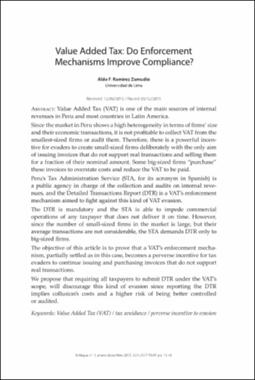Mostrar el registro sencillo del ítem
Value Added Tax: Do Enforcement Mechanisms Improve Compliance?
| dc.contributor.author | Ramirez Zamudio, Aldo Fabricio | |
| dc.contributor.other | Ramirez Zamudio, Aldo Fabricio | |
| dc.date.accessioned | 2016-12-02T21:27:30Z | |
| dc.date.issued | 2015 | |
| dc.identifier.citation | Ramirez Zamudio, A. (2015). Value Added Tax: Do Enforcement Mechanisms Improve Compliance? Enfoque, (1), 13-43. | es_ES |
| dc.identifier.issn | 2517-9349 | |
| dc.identifier.uri | https://hdl.handle.net/20.500.12724/2401 | |
| dc.description.abstract | Value Added Tax (VAT) is one of the main sources of internal revenues in Peru and most countries in Latin America. Since the market in Peru shows a high heterogeneity in terms of fi rms’ size and their economic transactions, it is not profi table to collect VAT from the smallest-sized fi rms or audit them. Therefore, there is a powerful incentive for evaders to create small-sized fi rms deliberately with the only aim of issuing invoices that do not support real transactions and selling them for a fraction of their nominal amount. Some big-sized fi rms “purchase” these invoices to overstate costs and reduce the VAT to be paid. Peru’s Tax Administration Service (STA, for its acronym in Spanish) is a public agency in charge of the collection and audits on internal revenues, and the Detailed Transactions Report (DTR) is a VAT’s enforcement mechanism aimed to fi ght against this kind of VAT evasion. The DTR is mandatory and the STA is able to impede commercial operations of any taxpayer that does not deliver it on time. However, since the number of small-sized fi rms in the market is large, but their average transactions are not considerable, the STA demands DTR only to big-sized fi rms. The objective of this article is to prove that a VAT’s enforcement mechanism, partially sett led as in this case, becomes a perverse incentive for tax evaders to continue issuing and purchasing invoices that do not support real transactions. We propose that requiring all taxpayers to submit DTR under the VAT’s scope, will discourage this kind of evasion since reporting the DTR implies collusion’s costs and a higher risk of being bett er controlled or audited. | |
| dc.format | application/pdf | |
| dc.language.iso | spa | |
| dc.publisher | Universidad de Lima | |
| dc.rights | info:eu-repo/semantics/openAccess | * |
| dc.rights.uri | https://creativecommons.org/licenses/by-nc-sa/4.0/ | * |
| dc.source | Repositorio Institucional - Ulima | |
| dc.source | Universidad de Lima | |
| dc.subject | Impuesto al valor agregado | |
| dc.subject | Value added tax | |
| dc.title | Value Added Tax: Do Enforcement Mechanisms Improve Compliance? | es_PE |
| dc.type | info:eu-repo/semantics/article | |
| dc.identifier.journal | Enfoque | |
| dc.publisher.country | PE | |
| dc.type.other | Artículo |
Ficheros en el ítem
Este ítem aparece en la(s) siguiente(s) colección(ones)
-
Economía [34]


